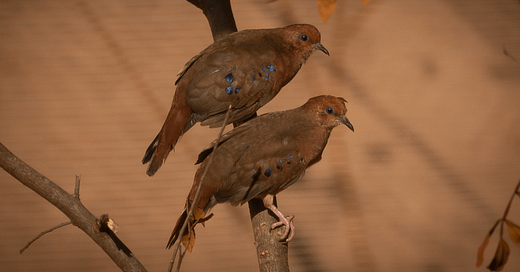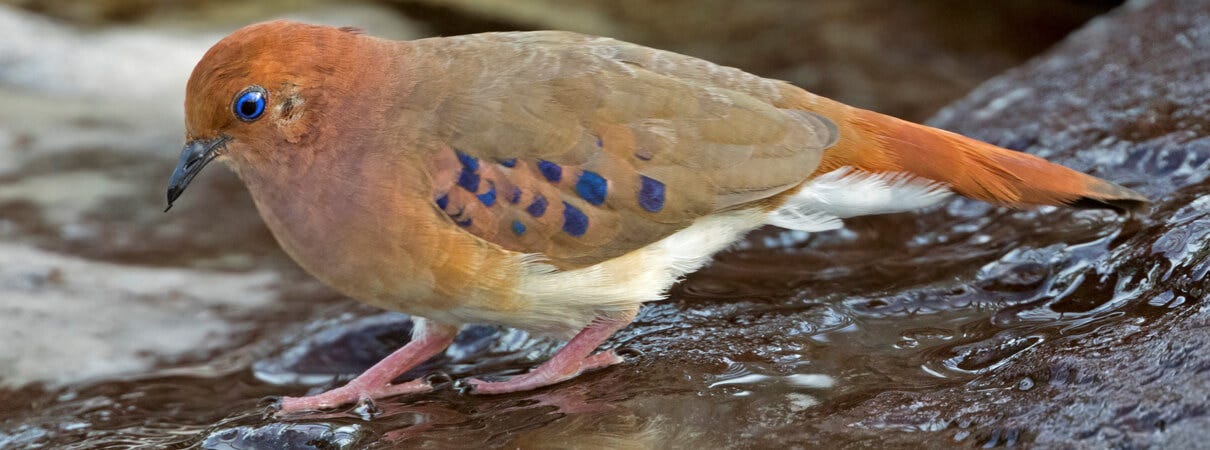The last confirmed sighting of the Blue-eyed Ground-Dove was in 1941. It was presumed extinct until 2015 — for 75 years. Why? Well, some speculate that increased agricultural activity in the Cerrado led to the dove's false extinction and very real decline, but the true cause behind its disappearance is still largely a mystery. (We love good mysteries!)
But we’re not here for mysteries, unless they are good mysteries. We are here to celebrate accomplishment.
It this case it takes quite a team to raise a rare bird population by nearly 30%. This scientific team is international, the location is in Brazil and the bird is the blue-eyed ground dove.
Producing these adorable chicks is a major step forward on behalf of this critically endangered species.
In case you were wondering, here is a picture (courtesy of Parque Das Aves)
The effort, led by the aforethanked Parque das Aves was assisted by England’s Chester Zoo, as well as the US’ Toledo Zoo and Bronx Zoo.
Cheers for all.
Andrew Owen, Chester Zoo’s head of birds, traveled to Brazil to provide vital technical support, while Victoria Kaldis, lead keeper for birds at Chester Zoo, assisted directly with the intricate hand-rearing of the delicate chicks.
"It’s a real privilege for Chester Zoo to be involved in the work to help conserve the blue-eyed ground dove, this unique species is on the brink of extinction and without the dedication and passion of all the conservationists involved, including Chester Zoo’s bird staff, this bird may be lost forever." said Andrew Owen, the head of birds (what a great title!) at Chester Zoo.
How did this happen? I’ll tell you:
Earlier this year the international team carefully selected and incubated a small number of eggs from the larger set found in the wilderness of Brasil. The idea was to hedge against what may happen with unassisted chick birth, by trying to breed an "insurance population" with human care. This latter efforts free from the myriad threats faced by their wild counterparts.
In the wild, blue-eyed ground doves and their newborne young face a gauntlet of dangers. Natural predators like wild dogs, eat eggs and chicks before they fledge. This means not only do very few birds reach adulthood each year, but also creates a dangerous low level of genetic diversity.
As you can see, the blue-eyed ground dove’s appearance is not limited to the eyes. All these birds are identifiable by the orange/red/purble head and breast, and the blue spots on its wings. That said, the most distinguishing feature is, indeed, its bright blue eye whose color is only strengthened by the bird’s gray skin.
The International Union for Conservation of Nature (IUCN) has assessed the blue-eyed ground dove as Critically Endangered, citing an extremely small population (estimated between 50-249 mature individuals as of 2019) and rapid habitat loss due to the conversion of Cerrado’s open savannah and grasslands into pasture land.
Parque das Aves is now home to six blue-eyed ground doves. It was three. That’s more good math.
From here, scientists are setting a new goal. To begin breeding in their purpose-built aviaries, further ensuring the survival of the blue-eyed ground dove for generations to come.
That’s a good goal, but this recent news is good news.






